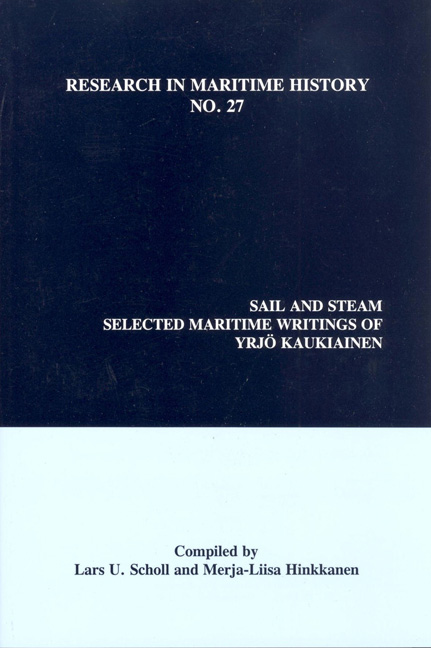Book contents
- Frontmatter
- Frontispiece
- Table of Contents
- Acknowledgements
- “Yrjö Kaukiainen: A Tribute on the Occasion of his Forthcoming Retirement as Professor of Maritime History at the University of Helsinki”
- “Yrjö Kaukiainen: A Man of the Sea”
- “Yrjö Kaukiainen and the Development of Maritime Economic History”
- “Finnish Sailors, 1750-1870”
- “Finnish and International Maritime Labour in the Age of Sail: Was There a Market?”
- “Five Years before the Mast: Observations on the Conditions of Maritime Labour in Finland and Elsewhere”
- “The Maritime Labour Market: Skill and Experience as Factors of Demand and Supply”
- “Owners and Masters: Management and Managerial Skills in the Finnish Ocean-Going Merchant Fleet, c. 1840-1880”
- “From Low-Cost to High-Cost Shipping: Finnish Maritime Labour Costs after the Second World War”
- “The Modernization of Finnish Coastal Shipping and Railway Competition c. 1830-1913”
- “British Timber Imports and Finnish Shipping 1860-1910”
- “Baltic Timber-Trade under Sail: An Example of the Persistence of Old Techniques”
- “Coal and Canvas: Aspects of the Competition between Steam and Sail, c. 1870-1914”
- “Dutch Shipping and the Swedish Navigation Act (1724). A Case Study”
- “Seamen Ashore: Port Visits of Late Nineteenth-Century Finnish Sailors”
- “Wreck-plundering by East Finnish Coastal People - Criminal Tradition or Popular Culture?”
- “From Days and Knots to Pounds and Dollars: Some Problems in the Study of the Economics of Late Nineteenth Century Merchant Shipping”
- “Tons and Tonnages: Ship Measurement and Shipping Statistics, c. 1870-1980”
- “International Freight Markets in the 1830s and 1840s: The Experience of a Major Finnish Shipowner”
- “Shrinking the World: Improvements in the Speed of Information Transmission, c. 1820-1870”
- “Yrjö Kaukiainen: A Maritime Bibliography”
“Shrinking the World: Improvements in the Speed of Information Transmission, c. 1820-1870”
- Frontmatter
- Frontispiece
- Table of Contents
- Acknowledgements
- “Yrjö Kaukiainen: A Tribute on the Occasion of his Forthcoming Retirement as Professor of Maritime History at the University of Helsinki”
- “Yrjö Kaukiainen: A Man of the Sea”
- “Yrjö Kaukiainen and the Development of Maritime Economic History”
- “Finnish Sailors, 1750-1870”
- “Finnish and International Maritime Labour in the Age of Sail: Was There a Market?”
- “Five Years before the Mast: Observations on the Conditions of Maritime Labour in Finland and Elsewhere”
- “The Maritime Labour Market: Skill and Experience as Factors of Demand and Supply”
- “Owners and Masters: Management and Managerial Skills in the Finnish Ocean-Going Merchant Fleet, c. 1840-1880”
- “From Low-Cost to High-Cost Shipping: Finnish Maritime Labour Costs after the Second World War”
- “The Modernization of Finnish Coastal Shipping and Railway Competition c. 1830-1913”
- “British Timber Imports and Finnish Shipping 1860-1910”
- “Baltic Timber-Trade under Sail: An Example of the Persistence of Old Techniques”
- “Coal and Canvas: Aspects of the Competition between Steam and Sail, c. 1870-1914”
- “Dutch Shipping and the Swedish Navigation Act (1724). A Case Study”
- “Seamen Ashore: Port Visits of Late Nineteenth-Century Finnish Sailors”
- “Wreck-plundering by East Finnish Coastal People - Criminal Tradition or Popular Culture?”
- “From Days and Knots to Pounds and Dollars: Some Problems in the Study of the Economics of Late Nineteenth Century Merchant Shipping”
- “Tons and Tonnages: Ship Measurement and Shipping Statistics, c. 1870-1980”
- “International Freight Markets in the 1830s and 1840s: The Experience of a Major Finnish Shipowner”
- “Shrinking the World: Improvements in the Speed of Information Transmission, c. 1820-1870”
- “Yrjö Kaukiainen: A Maritime Bibliography”
Summary
It is commonly believed that not much happened in the transmission of information before the introduction of the electric telegraph. This article, however, argues that this was not the case, that quite a substantial improvement in the speed of information transmission had already taken place a few decades before this technical breakthrough. Between 1820 and 1860, global dispatch times diminished remarkably, on average to about at third of what they had been around 1820. This implies that on most routes the improvement during these three decades amounted to more saved days than was achieved after the introduction of the electric telegraph. The development can be described as an evolution which started in Europe in the 1830s and was diffused gradually all over the world. The first transcontinental communications to benefit were those across the North Atlantic and to the Far East, with South America, Africa and Australia clearly trailing behind. The “take-off was initially connected with the introduction of steamships on coastal or short sea routes and subsequently on increasingly long ocean voyages. However, even traditional overland mail-coach connections improved as also did sailing-ship (“packet”) connections over the North Atlantic until the late 1830s. It was only in the late 1840s and 1850s that railways started to shrink distances within Continental Europe.
Introduction
I can only say that if we do not pay strict attention in writing & answering our Letters per every post, we had better leave writing at all and trust all to Chance.
This is how a late eighteenth-century foreign-trading merchant emphasised the importance of regular and active communications. In this respect he also voiced the views of many other colleagues: similar expressions arising from a dire thirst for news abound in the correspondence of foreign-trading merchant houses of the eighteenth or early nineteenth centuries. Because fresh information was scarce, the state of markets had to be monitored with the help of indicators such as local prices for export cargoes, customhouse export and import records and even the weather, which may have affected the speed of seaborne transport. It was not for nothing that many shipowners furnished their masters with long and detailed instructions trying to cover all unexpected situations - and always requiring them to write to the owners at the first opportunity after entering a port.
- Type
- Chapter
- Information
- Sail and SteamSelected Maritime Writings of Yrjö Kaukiainen, pp. 231 - 260Publisher: Liverpool University PressPrint publication year: 2004



